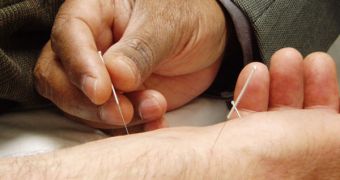The ancient craft of acupuncture has been with the Chinese people for thousands of years, and it has been used successfully to treat people ever since. The practice was not easily adopted in the West, mostly due to its spiritual component, and to the fact that it brings into focus details of the human body that cannot be readily verified empirically. However, as testified countless times over, acupuncture can be an effective tool in treating a wide variety of conditions, and slowly Western doctors are beginning to realize this. As part of ongoing efforts to better understand the practice, researchers recently managed to get more clues as to how it affects molecules inside the human body, PhysOrg reports.
The work revealed that the compound called adenosine is one of the main targets of acupuncture. This may help explain why sticking needles in specific spots on the skin can reduce pain and promote healing. Whenever we injure our skin, this naturally-occurring molecule is activated, numbing the nerve cells that would otherwise send impulses to the brain, creating the feeling of pain. In addition to acting like a natural painkiller, this substance also has a host of other functions in the body as well, including acting as a sleep regulator, having beneficial effects for the human heart, and possessing anti-inflammatory properties.
Adenosine works in similar ways to the painkiller lidocaine, scientists say, and this may help explain the effects of acupuncture. In deep tissues, where the tip of the needles act, more adenosine is produced, and this helps mitigate pains. Details of the new investigation, carried out by a team of researchers based at the University of Rochester, appear in the May 30 online issue of the top-rated scientific journal Nature Neuroscience. “Acupuncture has been a mainstay of medical treatment in certain parts of the world for 4,000 years, but because it has not been understood completely, many people have remained skeptical,” explains the leader of the research, UR neuroscientist Maiken Nedergaard, MD, DMSc.
“In this work, we provide information about one physical mechanism through which acupuncture reduces pain in the body,” the researcher adds. She is also the co-director of the Center for Translational Neuromedicine at the university. “It's clear that acupuncture may activate a number of different mechanisms. This carefully performed study identifies adenosine as a new player in the process. It's an interesting contribution to our growing understanding of the complex intervention which is acupuncture,” says the director of the National Center for Complementary and Alternative Medicine (NCCAM), Josephine P. Briggs, MD. The NCCAM is a division of the US National Institute of Health (NIH).

 14 DAY TRIAL //
14 DAY TRIAL //